
2011 (and the spillover from late 2010) marked a ridiculously good year in the development of comics. Or graphic novels if you care what people think of you. The medium experienced a couple works that will routinely find themselves in Best Of lists — and not just those treating 2011, but covering the entire history of the medium as well.
This is not a Top 10 list of 2011. I feel daunted by the sheer number of worthwhile books that came out last year (both those I've heard of and those I haven't). Time, money, and availability are the enemies of every reader who seeks to do his due diligence to the medium. Instead of a list of the best books of the year, I offer up 10 Good Books — something I can much more easily recommend in good conscience. These each are books worth the time and attention of discerning readers. These books may be highly entertaining or entirely discussion-worthy or deeply thoughtful or intriguingly complex or wonderfully simple. They may be any of these things or a collage of these perfections, but at the end of the day: these are Good Books.

by Gabriel Bá and Fábio Moon
published by DC/Vertigo
256 pages
Click for FULL REVIEW
Far and away my favourite release of 2011, Daytripper actually competes with Duncan the Wonder Dog (my favourite book from 2010) for the honour of being my favourite graphic novel of all time. Gorgeously illustrated in a manner that unveils the world through deep attention to detail, colour, and tone, the book explores not just the particular life of its protagonist but the nature of life generally. Daytripper is the story of Brás, a writer of obituaries who, at the end of each chapter, narrates his own demise — because at the end of each chapter, Brás dies. It's an interesting method of exploring life, its purpose, and its possibilities. By evaluating Brás' life in each moment it could end, Daytripper's creators prompt readers to investigate the value in their own lives. Powerful, worthwhile stuff.

by Craig Thompson
published by Pantheon
672 pages
Click for FULL REVIEW
Craig Thompson's epic-length follow-up to his roundly lauded semi-memoir Blankets is in many ways a more difficult work than what was previously considered his magnum opus. Habibi has been plagued by charges of sexualization, objectification, and Orientalism by those who, I would argue, don't quite understand the work. Still, this large book provides an all-you-can-eat shrimp buffet for thought and will give the more courageous book clubs piles to talk about. While exploring themes of Islamic tradition vs. Judeo-Christian tradition and playing with Miyazaki-level ecological concerns, the main purpose of the book seems to be an exploration of love vs. sex and the interaction of the two when sex is rendered impossible. Those interested in world religions especially will find Thompson's exploration of spiritual themes compelling as he continues to grow away from his fundamentalist roots and deeper into a confirmed atheism with an interest in religious traditions.

by Anders Nilsen
published by Drawn & Quarterly
658 pages
Click for FULL REVIEW
Maybe some books are there less for what they say and more for what they ask. Anders Nilsen, the man who wrote the worst graphic novel I've ever read (Monologues for the Coming Plague) also wrote one of the best. Big Questions, a 658-page doorstop of a book, tells the story of some finches, some crows, an idiot, a narcoleptic pilot, some donut crumbs, a snake, some squirrels, and a bomb. And it poses questions about life and purpose and meaning and faith.
Nilsen's book, in production for over a decade, is fascinatingly spare. Panels often float around the page with neither border nor background. The characters, primarily birds, often have nothing at all to say — or when they do, speak in staccato punctuations of ideas and questions. There's a lot going on in the book and it can be difficult to trace the author's thread in any unbroken sense throughout, but in the end the experience is worth the time invested. At a $45 cover, the price is a bit steep, but Amazon discounts or the judicious use of a library card can knock the wind out of that particular bugbear.

by Nate Powell
published by Top Shelf
304 pages
Click for FULL REVIEW
Nate Powell's exploration of the war-culture of the '80s (reflecting today's own of the same) skirts the bounds of surrealism and charts the lives of three children as they grow up and into a broken world whose demands are more violent than the fragile human spirit can bear. Powell is one of the brightest of the newer crop of comics creators who use the form to narrate complex ideas. His prior work, Swallow Me Whole, was a wonder of abstraction, focusing on mental disabilities and Any Empire continues his trend of creating compelling stories through superior visual technique.

by GB Tran
published by Villard
192 pages
Click for FULL REVIEW
Vietnamerica explores author GB Tran's family history through the primary obstacle of Tran's own history of disinterest. The reader charts along with Tran the incredible journey that his family had taken through the tumult of America's relations with Vietnam during the '60s and beyond. Tran allows readers to eavesdrop while he himself as an adult learns about his family's life in Vietnam before he was born and leading up to Saigon's fall. He sprinkles in anecdotes from his parents' attempts to integrate into the American landscape. Tran's artwork is beautiful and his easy linework and painted colour help turn Vietnamerica into something much more than Maus in Vietnam.

by Mike Mignola, John Arcudi, and Guy Davis
published by Dark Horse
1462+ pages
Click for FULL REVIEW
When Mike Mignola spun off from Hellboy a series featuring the Bureau of Paranormal Research and Defense, I wasn't excited. The first two volumes of the series ran about as well as I had expected. Neither were bad but neither were particularly good. Then, out of the blue it seemed, with the release of volume 3, BPRD turned some kind of corner, becoming the most exciting adventure/horror series on the market. That was in 2004 and the train just keeps barreling along. The first arc of the BPRD's story, now known as Plague of Frogs, wrapped up cataclysmically in December 2010 and paved the way for the next year's developments. The new arc, Hell on Earth, explores a world out of Lovecraftian-style terror, where the walls between our world and another begin to collapse and creatures alien to our experience begin the creep, crawl, and burst through. Watching as the BPRD's agents work hard to control damage in a war that the world is (at for the moment) clearly losing is exciting and I await each new volume with an excitement I feel for few books.

by jim Ottaviani and Leland Myrick
published by First Second
272 pages
Click for FULL REVIEW
Richard Feynman may be the funniest physicist to ever live. He is, at least, the funniest I've ever encountered. Jim Ottaviani's biographical comic goes a long way toward capturing the whimsy with which Feynman approached the universe. The chief goal of Feynman, perhaps, is to bring readers to understand the physicist's own chief goal: that we should recognize the inexplicable and wondrous in our universe and acknowledge when such a thing is beyond us.
One of the abiding motifs that Feynman's character hopes to impress upon the reader is the infinite complexity of physical things. Scientists have names and formulae to describe any number of processes that govern our world, but do they truly understand these things or are they just ridiculously dedicated to the art of taxonomy? Feynman, in a number of ways, cynically suggests the latter. After all, there's only so much headway the finite can make when rushing toward the infinite.

by Kate Beaton
published by Drawn & Quarterly
168 pages
Click for FULL REVIEW
I almost stopped believing that joie de vivre in comic strips could exist in the post-Calvin & Hobbes world. Generally speaking, newspaper strips just aren't funny. Kate Beaton, however, proves that they absolutely can be — that comic strips can be smart and witty and urbane and culturally acute (even if the culture she appropriates is generally more than a century passé — fans of CAPC column "Eat Your Vegetables" should get more out of the book than the average reader). Hark A Vagrant! is a rare work in that it shows what the newspaper comics page ideally could have become if it hadn't been overrun with uninspired and unfunny legacy comics for years and years and years.

by Vera Brosgol
published by First Second
224 pages
Click for FULL REVIEW
Generally speaking, YA lit just doesn't ring true at all. The tropes of high school melodrama are well established and we recognize them from cultural artifacts like books and movies but not from reality itself. Still, there are always a few works of the genre that don't play to cliché and, thankfully, Anya's Ghost avoids most of the usual traps of the form. There are even moments when I found myself gleefully surprised at a direction in which Vera Brosgol would choose to take her story. Anya's Ghost is about three things: a girl named Anya, high school shenanigans, and, of course, a ghost. The joy of the book is in the details of how the story all works out rather than in the genius of any of the three parts on their own.
Brosgol works hard to make Anya a character who very easily could be weird or strange or unwelcome but isn't. She's an immigrant teen and by her word we learn that she's worked very hard to compensate for her inauspicious country of origin. She's overcome her accent, acclimated to the cultural diversity of young American life, and doesn't dress like someone who's just discovered clothes. She's embarrassed by her native culture and goes to lengths to distance herself from that which will mark her as Foreign. Sometimes that means shortening an obnoxiously difficult-to-pronounce last name and sometimes it means forsaking the other kid from your country who hasn't quite overcome his eager-foreigner tendencies yet. It's an interesting take on the concept of being The Other and Brosgol does a good job of always keeping the story accessible.

One of the greatest boons to American experience of the medium in the last ten years is the explosive import of Japanese comics (colloquially known as manga). Currently, there are numerous series of thoughtful, intelligent work being published (many of these through Viz's Signature line). Each of these is worth readers' time and attention. I'll give a brief overview of several titles that I'm personally invested in and look forward to regularly.
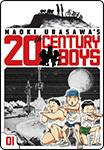 20th Century Boys
20th Century Boys
by Naoki Urusawa
published by VIZ
Naoki Urasawa (creator of Monster and Pluto) is putting forth a strange, exciting thriller in which a group of childhood friends reunite in their adulthood to stop a dangerous, possibly world-ending cult that they may have accidentally created from their imaginations back in elementary school. Like a lot of manga, it does a good job sublimating the idea of a status quo and shakes things up enough that the reader never gets too comfortable.
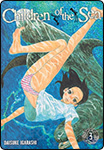 Children of the Sea
Children of the Sea
by Daisuke Igarashi
published by Viz
Click for FULL REVIEW
While the series seems to be on indefinite hiatus (no news of a vol. 5 yet), the four available volumes to the story present a completely unique comics experience. Children of the Sea tells the story of two young teens: Ruka and Umi. Ruka is the not-atypical daughter of a broken family. She lives with her mother but hides out at her father's aquarium. Umi is a boy who, along with his brother Sora, was found as a toddler being raised by dugongs (a.k.a. manatees, a.k.a. sea cows). Both Umi and Sora are more at home in the water than on land and their bodies have specially adapted to deep-sea free diving and swimming incredibly long distances with an ease unheard of by normal humans. Ruka shares with them a special kind of vision, a way of seeing the ocean and its inhabitants. There is a sense of reverence and oneness between these three and the creatures of the deep. Fascinating series.
 Cross Game
Cross Game
by Mitsuru Adachi
published by Viz
Click for FULL REVIEW
Explores the power of romantic and familial love to fuel childhood promises across intervening years. Ko is a high school baseball star and is driven by a dream that Wakaba had for him in their childhood, that he and rival Akaishi would play together in the Koshien (Japan's high-school–level World Series equivalent). Touching, exciting, humourous, and compulsively readable. Note: don't let the baseball theme dissuade you from giving this a try; neither my wife nor I care anything for baseball, yet both of us adore the series. (Series releases one oversize volume every three months and should wrap in Summer 2012.)
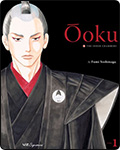 Ooku: The Inner Chamber
Ooku: The Inner Chamber
by Fumi Yoshinaga
published by Viz
Click for FULL REVIEW
A reimagination of Japanese history that takes a kind of note from Brian K. Vaughan's Y the Last Man. Taking place during the 17th century, Ooku posits a female Tokugawa shogunate in the wake of the red-face pox, a plague that mysteriously wipes out three quarters of the nation's men. The book (through more feminist eyes) retells engagingly the alt-history of Japan in a smart, thrilling, and surprisingly romantic manner. (Series releases one volume per year and should wrap in 2015 at a total of ten volumes.)
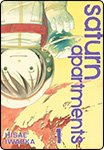 Saturn Apartments
Saturn Apartments
by Hisae Iwaoka
published by Viz
Click for FULL REVIEW
Window washers in space! Saturn Apartments is a fake sci-fi book. It takes place on a ring satellite in low orbit above the earth and there are space suits and all, but the book is really just an opportunity for superflat artist Hisae Iwaoka to explore the lives and dreams of the characters she's created. It's an exciting book to take part in as its release gradually unfolds. Generally, I prefer to take in a series once its publication is complete (thereby eliminating the story-hindering two-to-ten-month wait between volumes), but Saturn Apartments is such a quiet pleasure for me that I'm happy to take it in whatever chunks are available.
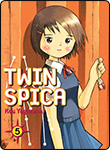 Twin Spica
Twin Spica
by Kou Yaginuma
published by Vertical
Click for FULL REVIEW
A sweet, heart-twisting tale of a girl, a ghost, and a dream to reach the stars. Ayumi is a small (under 5 ft) teenage girl who's enrolled in astronaut school and hopes to be among the first astronauts in Japan's space program since a horrific rocket disaster over a decade earlier. The books explore the pasts and presents of Ayumi and her friends as they seek to overcome the various challenges their unique life-circumstances have dictated. Best not read in public if misting up embarrasses you. (Twin Spica is released bi-monthly and will be 16 volumes long, completing its series in October 2012.)
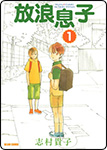 Wandering Son
Wandering Son
by Shimura Takako
published by Fantagraphics
Nitori is a fifth grader who wishes he was a girl and gradually finds himself dressing like one. Takatsuki is a fifth grader who wishes she were a boy and is happy to dress as one. The book explores issues of gender identiation and transexuality across the landscape of the onset of puperty. It's a fascinating work that hypothesizes the difficulties that journeying through such circumstnces might accrue.
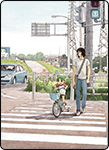 Yotsuba&!
Yotsuba&!
by Kiyohiko Azuma
published by Yen Press/ADV
Click for FULL REVIEW
Perhaps the most charming book in the entire world, Yotsuba&! cannot really be described apart from the experience of the book itself. A lovely little series.
Good Ok Bad features reviews of comics, graphic novels, manga, et cetera using a rare and auspicious three-star rating system. Point systems are notoriously fiddly, so here it's been pared down to three simple possibilities:
3 Stars = Good
2 Stars = Ok
1 Star = Bad
I am Seth T. Hahne and these are my reviews.
Browse Reviews By
Other Features
- Best Books of the Year:
- Top 50 of 2024
- Top 50 of 2023
- Top 100 of 2020-22
- Top 75 of 2019
- Top 50 of 2018
- Top 75 of 2017
- Top 75 of 2016
- Top 75 of 2015
- Top 75 of 2014
- Top 35 of 2013
- Top 25 of 2012
- Top 10 of 2011
- Popular Sections:
- All-Time Top 500
- All the Boardgames I've Played
- All the Anime Series I've Seen
- All the Animated Films I've Seen
- Top 75 by Female Creators
- Kids Recommendations
- What I Read: A Reading Log
- Other Features:
- Bookclub Study Guides









